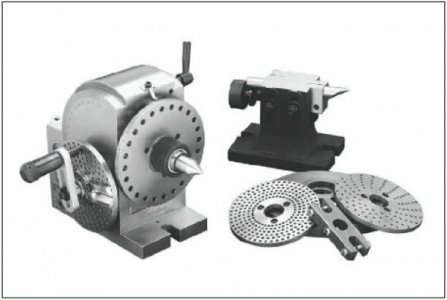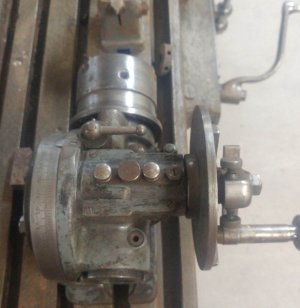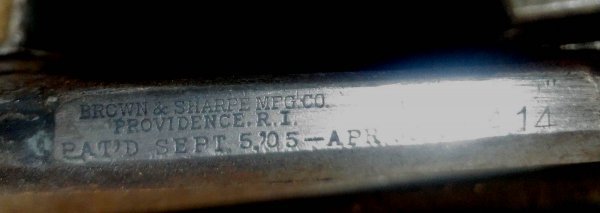- Joined
- Feb 13, 2017
- Messages
- 2,138
I am aware of the usual indexing heads. What I have(had) is available from Grizzly, shown below.

A Brown&Sharps clone, 6” capacity, relatively small, as indexers go. I mostly build models, and do fairly small machining jobs. It would barely fit on an Atlas MF bench-top miller. Not much room to work with. I also have a smaller indexer, a 4” rotary table fitted with a fraction plate and home brew base plate. That serves most of my work, repairing broken stuff, that sort of thing. But occasionally, I need to work something bigger and the clone wouldn't fit the miller.
Prowling the other day on E-Bay, I spotted an archaic(?) or “one of a kind” indexer. Only half the size, and at a price I was willing to pay. The deal of the decade to me. And a real B&S, too. None of this clone business. I've just got to crow about it. Still needs cleaning up, I just wanted to show it off, and do a little research into the patent date.


Sept of 1905 is a little before my time, I've never seen or heard of such a device. Of course I'm not a machinist, just a hobbyist. The chuck is a fuzz under 3” diameter, the fraction plate a fuzz over 5”. Center height a fuzz under 2-1/2”. A fuzz?, just a whisker smaller than a hair. With the proper alignment pegs, I think it will fit the miller with enough room to do some respectable sized work.
Over the years, I have scrounged several fraction plates. Usually from scrap metal people that have no idea what they are. Just round and pretty to them. A couple double sided. I think they might be “modified” to fit this older indexer. And a couple with higher prime numbers, up to 97 as I remember, that someone thought were motor cycle brake disks. Those might be a problem though, over 12” across. Obviously for a somewhat larger device than I had.
I am told that antiques lose their value if refinished. ?Does this apply as well to machine tools? I am thinking when I disassemble it to clean and relube about repainting too. A PITA to scratch a new paint job while working. But, a thought. There isn't any rust to speak of, maybe just keep it oiled.
Any input with pointers or links to such early parts would be appreciated. It obviously predates the more modern designs. Just how old is mechanized indexing, anyway? I tried several web sites, and Wikipedia. They all have the device like Grizzly has. The only entry I could find was on E-Bay.

A Brown&Sharps clone, 6” capacity, relatively small, as indexers go. I mostly build models, and do fairly small machining jobs. It would barely fit on an Atlas MF bench-top miller. Not much room to work with. I also have a smaller indexer, a 4” rotary table fitted with a fraction plate and home brew base plate. That serves most of my work, repairing broken stuff, that sort of thing. But occasionally, I need to work something bigger and the clone wouldn't fit the miller.
Prowling the other day on E-Bay, I spotted an archaic(?) or “one of a kind” indexer. Only half the size, and at a price I was willing to pay. The deal of the decade to me. And a real B&S, too. None of this clone business. I've just got to crow about it. Still needs cleaning up, I just wanted to show it off, and do a little research into the patent date.


Sept of 1905 is a little before my time, I've never seen or heard of such a device. Of course I'm not a machinist, just a hobbyist. The chuck is a fuzz under 3” diameter, the fraction plate a fuzz over 5”. Center height a fuzz under 2-1/2”. A fuzz?, just a whisker smaller than a hair. With the proper alignment pegs, I think it will fit the miller with enough room to do some respectable sized work.
Over the years, I have scrounged several fraction plates. Usually from scrap metal people that have no idea what they are. Just round and pretty to them. A couple double sided. I think they might be “modified” to fit this older indexer. And a couple with higher prime numbers, up to 97 as I remember, that someone thought were motor cycle brake disks. Those might be a problem though, over 12” across. Obviously for a somewhat larger device than I had.
I am told that antiques lose their value if refinished. ?Does this apply as well to machine tools? I am thinking when I disassemble it to clean and relube about repainting too. A PITA to scratch a new paint job while working. But, a thought. There isn't any rust to speak of, maybe just keep it oiled.
Any input with pointers or links to such early parts would be appreciated. It obviously predates the more modern designs. Just how old is mechanized indexing, anyway? I tried several web sites, and Wikipedia. They all have the device like Grizzly has. The only entry I could find was on E-Bay.
Bill Hudson

